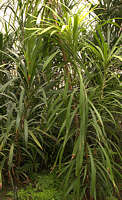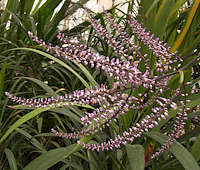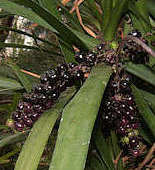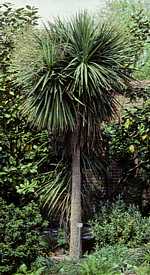|
The genus Cordyline includes 15 - 20 species of woody flowering monocotyledons from the Western Pacific area including Eastern Australia, New Zealand, Polynesia, Hawaii and South-East Asia including India. Six species from New Zealand are of interest for temperate gardens.
Classification of Cordyline is controversial. The genus has been variously included in the Agavaceae, Asteliaceae, Liliaceae and Dracaenaceae. According to the latest classification, Cordylline is placed in the sub-family Lomandroideae within the Order Asparagales. As a generality, Cordylines have white roots and Dracaenas have orange roots.
See also:
International Cordyline Society
|
|
Cordyline australis Endlicher 1836 (Cabbage Palm)
This palm-like succulent tree from New Zealand has a single trunk up to 30 ft but usually 10-15 ft. Unlike most real palms the trunk may branch after flowering and can recover from losing its apical bud. The trunk of mature plants may have a crown of many branches each carrying a tuft of leaves. The root of Cordyline australis is a large white rhizome with fibrous roots, which may account for over a quarter of the total biomass of the plant.
The stiff sword-like leaves are 2-3 ft long and 1-2 inches wide and do not have the sharp terminal spines or sharp edges associated with many Agavaceae.
Flowers (lower right) are panicles of tiny creamy-white sweetly fragrant flowers followed by numerous small green berries becoming cream or purple coloured.
Brightly coloured cultivars of the Cabbage Palm are becoming available, but may be less hardy than the parent.
|
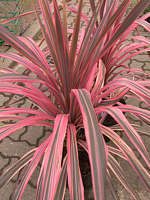 C. australis C. australis cv. "Southern Splendour" 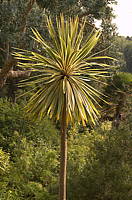 C. australis C. australis cv. "Torbay Dazzler" 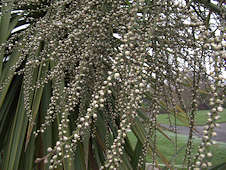 C. australis berries 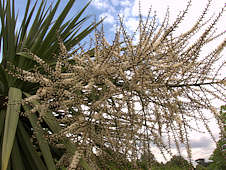 C. australis flowers 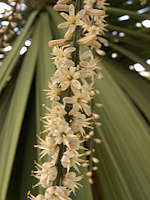 C. australis flowers |
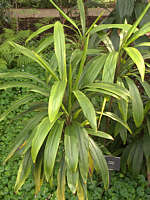 |
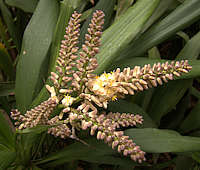 |
Cordyline canniifolia R. Brown 1810 (Palm Lily) is a shrubby understorey plant, native to rainforests and eucalyptus forests in northern Queensland and the Northern Territory of Australia.
The thin brown 5-10ft canes are crowned with glossy-green, lanceolate leaves whose under-surface is a glaucous green. The pendulous raceme of small white flowers is followed by red berries.
|
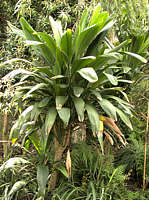 |
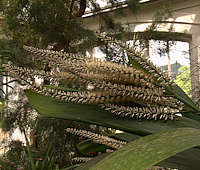 |
Cordyline fruticosa Chevalier 1919 (Hawaian Ti plant)
is a shrubby tree up to 10ft tall with a stout, unbranched trunk bearing tufts of leaves at the top, sometimes suckering from the basal tuberous rhyzome. The large, glossy sword-shaped leaves on long petioles, may be green to reddish-purple or marked with purple, red, yellow or white. The inflorescence from a mature plant is a cluster of sweetly-scented small yellow to red flowers followed by clusters of red berries.
|
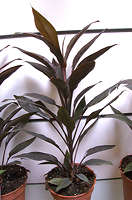 |
Cordyline fruticosa probably originated in South-East Asia and Papua New Guinea, but was spread throughout the Pacific area by Polynesian migrants who used the starchy rhizomes for food. The leaves were used to make the traditional Hawaiian hula skirt and for thatching houses.
Cordyline fruticosa is often sold as a small foliage plant without a trunk, when leaves are present along the entire stem. Numerous variegated and brightly coloured cultivars are available. Plants tolerate shade to bright light and appreciate humidity, but hot dry sun may scorch the leaves.
Left: Cordyline fruticosa cv. tango
|
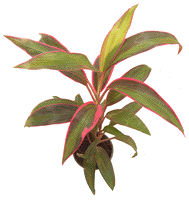 |
Right: Cordyline indivisa Endlicher 1836 (Mountain or Broad-Leaved Cabbage Tree)
has much wider glaucous leaves than Cordyline australis. The leaves of the small specimen shown here were about 4 inches wide in the middle compared with around 2 inches wide for those of C. australis.
Cordyline indivisa is native to the mountains of New Zealand, especially in Eastern parts of the South Island, and is grown as an ornamental plant in milder parts of Great Britain and Southern Ireland where frost is rare. It makes a distinctive feature plant with an exotic appearance. When stressed by heat, water shortage or attacked by the bacterium Phytoplasma australiense, the plants may undergo sudden collapse.
|
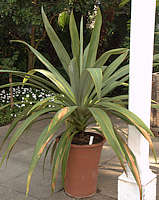 |
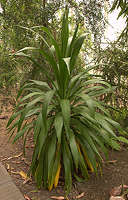 |
Cordyline obtecta Baker 1875 (Norfolk Island Cabbage Tree)
Name: Latin obtegere = to conceal or cover up, referring to flowers scarcely protruding beyond the leaves.
This species is a large tree up to 30 ft tall, with a stout, branching trunk. The lanceolate 3 ft leaves are up to 3 inches wide, clustering at the end of branches. The inflorescence is a branching panicle with many small perfumed flowers, held among the leaves. Flowers are followed by small white to purple berries.
Native to Norfolk Island and to Northern New Zealand.
|
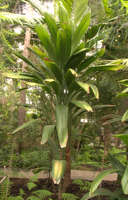 |
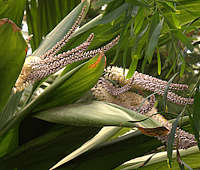 |
Cordyline petiolaris Pedley 1986 (Broad-Leaved Palm Lily)
is native to rainforests and eucalyptus forests of North-Eastern New South Wales and South-Eastern Queensland.
The narrow 20ft trunk carries a crown of glossy-green, eliptical leaves with exceptionally long, inrolled petioles (leaf stalks), hence the epiphet petiolaris. Fraying or browning of the leaf tips is characteristic. Panicles of small, white to pale pink flowers are produced from the upper leaf axils, and are followed by dark-red berries.
|
Cordyline stricta Endlicher 1836 (Narrow Palm Lily)
is native to rainforests and eucalyptus forests of North-Eastern New South Wales and South-Eastern Queensland. This plant is widely cultivated as a container plant, but is not frost hardy.
Cordyline stricta has an unbranching stem up to 15 ft tall, bearing long, linear 2 ft leaves about an inch wide. The leaf bases form a green sheath around the stem. Panicles of small white to purple flowers are produced, mostly from the upper leaf axils and are followed by black berries. The plant spreads by suckering.
|
Cultivation
With their smoothly-edged leaves and absence of terminal spines, Cordylines are suitable for planting near paths or in patio planters. The leathery leaves tolerate a certain amount of abuse. Use a free-draining potting mixture to protect the succulent tuberous rhyzomes against excessive wet.
Cordyline australis is used extensively in landscaping in temperate climates. Many large specimens can be seen in Southern England. The potential to grow 30 ft tall should be borne in mind when planting a small Cordyline australis near a building. The root of Cordyline australis is a large white rhizome with fibrous roots, which may account for over a quarter of the total biomass of the plant. While not generally considered invasive, the root mass could press against adjacent structures causing damage.
Cordyline australis is the most cold-hardy Cordyline and cold wet roots or penetration of cold water into the growing point are more likely to kill the plant than frost. A young plant can have its crown protected with straw during winters, until established. Dead leaves tend to remain as felting on the stem, and can generally be removed. However, they do provide some protection and help to collect moisture in dry climates.
Other Cordyline species grow as small shrubs suitable for patio pots that can be brought indoors or covered before the first frosts.
Numerous variegated and brightly coloured cultivars are available, especially of C. fructicosa and C. terminalis. Hot dry sun may burn the leaves and the plants appreciate humidity. Propagation is generally easy from cuttings, rhyzome division or seed.
|
